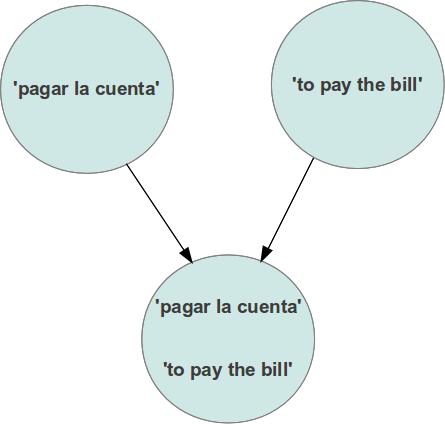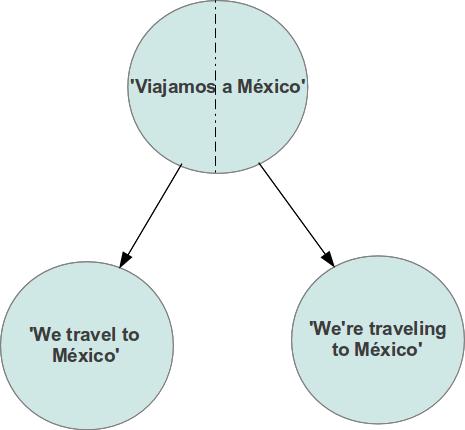You are here
6.1 Literal meaning and translation issues
The meaning of a word that you can find in a dictionary can be referred to as the literal meaning of that word. Unlike the connotative meaning, which is meaning that is derived by association with other words or phrases, literal meaning is that which is held by the word in itself, for example that the word “door” refers to a movable structure that is used to close off an entrance to a building or room. We will discuss connotative meaning in the next lesson. In this lesson we will explore issues related to translating the literal meaning of words from one language into another. This should not be confused with literal translation, a term which we used in Lesson One to refer to translation that transfers the exact words and grammar of the source text according to the rules of the source language into the target language (which often results in incorrect grammar and a target text which is difficult to understand). Here we will be focusing on how to transfer the literal meaning of words from the SL into the TL in a way that is correct and naturally expressed in the TL.
a) Synonymy
You may be familiar with the word synonym. It is usually used to describe two words in the same language that have the same, or a very a similar, meaning. For example, in Spanish, “lindo” is a synonym of “bonito”, both have about the same literal meaning and range of use. The concept of synonymy can be extended to apply to words, or phrases with multiple words, that have the same literal meaning in two different languages. For example “Mi hijo” in Spanish achieves synonymy with “My son” in English, both have the same meaning and neither is more general or specific than the other. Synonymy can be present between individual words, between phrases with multiple words, or sometimes a combination of both. For example:
Example 6.1
| Types of synonymy | Spanish | English |
| Synonymy between two words | dinero | money |
| Synonymy between two phrases | pagar la cuenta | to pay the bill |
|
Synonymy between a word and a phrase |
madrugar | to get up early |
The concept of synonymy can be visualized as shown in figure 6.1.
Figura 6.1

Words or phrases are fully synonymous when their literal meanings completely overlap and no part of the message is added to or omitted from the SL word or phrase when rendered in the TL. When full synonymy is not achieved, we refer to the problem as non-equivalence.
b) Hypernymy & hyponymy
Unfortunately, it is often the case that full synonymy cannot be reached between words or phrases in two different languages. Consider what we learned in Lesson 4 about the Spanish present tense having multiple usages. A phrase like, “Viajamos a México” could be translated as “We travel to Mexico” or “We’re traveling to Mexico”, depending on whether the action is habitual (We travel) or takes place in the future (We’re traveling). For example if the full sentence is “Viajamos a México a menudo” the translation would be: “We travel to Mexico often.” If the sentence were “Viajamos a México el próximo verano” the translation would be: “We are traveling to Mexico next summer”). Therefore, “Viajamos a México” and “We travel to Mexico” are not full synonyms but rather have different ranges of meaning - the Spanish sentence covers a wider range of possible situations than the English sentence. See figure 6.2:
Figure 6.2

Words can be compared to one another and observed to be more general or specific. In linguistics we can use the two following terms to describe whether a word or phrase is more general or specific than another within one language or between two languages:
hypernym: a word which has a wider, more general literal meaning
hyponym: a word with a narrower, more specific literal meaning
In our example of “Viajamos a México”, the Spanish phrase is a hypernym of the English “We travel to Mexico” because the Spanish phrase is less specific and includes a broader range of possible meanings.
As an example between two words in Spanish, “escuela” is a hypernym of “universidad” because it is less specific (“universidad” is a hyponym of “escuela” because it is more specific).
For an example between two phrases in English:
Example 6.2
Phrase 2: “I make the child support payments”
Phrase 1 is a hypernym of Phrase 2 because it has a broader meaning, while Phrase 2 is a hyponym of Phrase 1 because it has a more specific meaning.
To offer another example of hypernymy - hyponymy between sentences in Spanish and English:
Example 6.3
Source Text
Target Text 1
Target Text 2
Since “hermanos” in Spanish could refer strictly to “brothers” in English or to “brother/s and sister/s” in which case we would use the word “siblings”, the Spanish phrase “Él nunca se pelea con sus hermanos” is has a wider range than either the English phrase “He never fights with his brothers” or “He never fights with his siblings” and is therefore a hypernym. If we needed to translate this sentence we would rely on the context and surrounding information to decide if “brothers” or “siblings” were correct in English. And if there were not any hints, we would choose “siblings” as it is the more neutral word and would still be acceptable even if all of the siblings were brothers.
